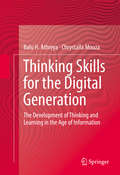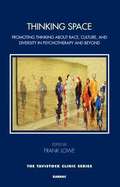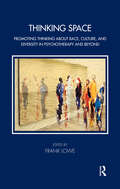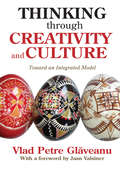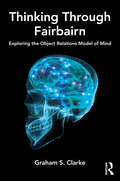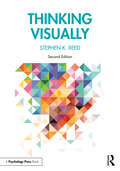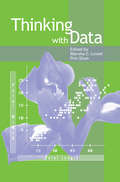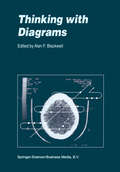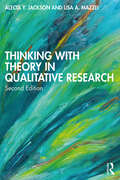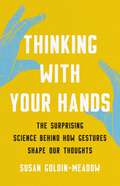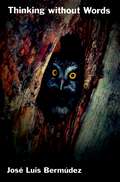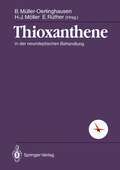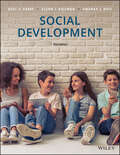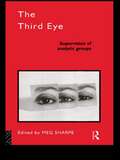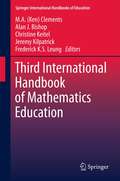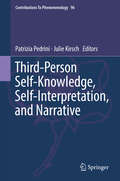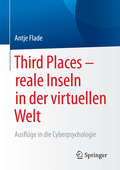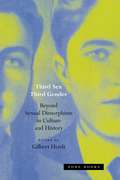- Table View
- List View
Thinking Skills for the Digital Generation: The Development of Thinking and Learning in the Age of Information
by Balu H. Athreya Chrystalla MouzaThis important text synthesizes the state of knowledge related to thinking and technology and provides strategies for helping young people cultivate thinking skills required to navigate the new digital landscape. The rise of technology has resulted in new ways of searching and communicating information among youth, often creating information “overload”. We do not know how the new technologies will affect the ways young people learn and think. There are plenty of warnings about the dangers of information technology, but there is also enormous potential for technology to aid human thinking, which this book explores from an open-minded perspective.Coverage Includes:- An up to date review of the literature on thinking skills in general, and in relation to technology.- Practical guidelines for thinking with technology.- A scholarly review of the characteristics of the digital generation.- A discussion of the various steps involved in the thinking process.- A historical context of the Information Age and the transition from oral history, to printing press, to the Internet.Thinking Skills for the Digital Generation: The Development of Thinking and Learning in the Age of Information is an invaluable reference for educators and research professionals particularly interested in educational technology, and improving thinking and problem-solving skills.
Thinking Space: Promoting Thinking About Race, Culture And Diversity In Psychotherapy And Beyond (PDF)
by Frank LöweThinking Space was set up to develop the capacity of staff and trainees at the Tavistock Clinic to think about racism and other forms of hatred toward difference in ourselves and others. Drawing on Bion's (1962) distinction between "knowing" and "knowing about", the latter of which can be a defense against knowing a subject in a deeper and emotionally real way, Thinking Space sought to promote curiosity, exploration and learning about difference, by paying as much attention as to how we learn (process) as to what we learn (content). This book is a celebration of ten years of Thinking Space at the Tavistock Clinic and a way of sharing the thinking, experience and learning gained over these years. Thinking Space functions, among other things, as a test-bed for ideas and many of the papers included here began as presentations, and were encouraged and developed by the experience. These papers do not seek to provide a coherent theory or set of views. On the contrary they are very diverse and decidedly so, as finding, expressing and developing one's own personal idiom involves emotional truthfulness and is an important part of getting to know oneself: both of which are important prerequisites to getting to know the other.
Thinking Space: Promoting Thinking About Race, Culture and Diversity in Psychotherapy and Beyond (Tavistock Clinic Series)
by Frank LoweThis book promotes curiosity, exploration and learning about difference by paying as much attention as to how we learn (process) as to what we learn (content). It shares the thinking, experience and learning of staff at the Tavistock Clinic, the premier psychotherapy training institution in the NHS.
Thinking Space: Promoting Thinking About Race, Culture and Diversity in Psychotherapy and Beyond (Tavistock Clinic Series)
by Frank LoweThis book promotes curiosity, exploration and learning about difference by paying as much attention as to how we learn (process) as to what we learn (content). It shares the thinking, experience and learning of staff at the Tavistock Clinic, the premier psychotherapy training institution in the NHS.
Thinking Through Creativity and Culture: Toward an Integrated Model
by Vlad Petre GlaveanuCreativity and culture are inherently linked. Society and culture are part and parcel of creativity's process, outcome, and subjective experience. Equally, creativity does not reside in the individual independent of culture and society.Vlad Petre Glveanu's basic framework includes creators and community, from which new artifacts emerge and existing artifacts are developed. He points to a relationship between self and other, new and old, specific for every creative act. Using this multifaceted system requires that researchers employ ecological research in order to capture the heterogeneity and social dimensions of creativity.Glveanu uses an approach based on cultural psychology to present creativity in lay terms and within everyday settings. He concludes with a unitary cultural framework of creativity interrelating actors, audiences, actions, artifacts, and affordances.
Thinking Through Creativity and Culture: Toward an Integrated Model (History And Theory Of Psychology Ser.)
by Vlad Petre GlaveanuCreativity and culture are inherently linked. Society and culture are part and parcel of creativity's process, outcome, and subjective experience. Equally, creativity does not reside in the individual independent of culture and society.Vlad Petre Glveanu's basic framework includes creators and community, from which new artifacts emerge and existing artifacts are developed. He points to a relationship between self and other, new and old, specific for every creative act. Using this multifaceted system requires that researchers employ ecological research in order to capture the heterogeneity and social dimensions of creativity.Glveanu uses an approach based on cultural psychology to present creativity in lay terms and within everyday settings. He concludes with a unitary cultural framework of creativity interrelating actors, audiences, actions, artifacts, and affordances.
Thinking Through Fairbairn: Exploring the Object Relations Model of Mind
by Graham S. ClarkeThinking through Fairbairn offers parallel perspectives on Fairbairn's work. It explores an extended interpretation of his 'psychology of dynamic structure' and applies that model to a number of different areas. Fairbairn's Scottish origins are explored through his relationship with the work of Ian Suttie and Edward Glover. A new extended object relations model of phantasy and inner reality that reflects Fairbairn's approach as represented by his contribution to the Controversial Discussions is also developed. In cooperation with Paul Finnegan, this version of Fairbairn's model is applied to an understanding of multiple personality disorder or dissociative identity disorder. This model is combined with Fairbairn's theory of art to provide an understanding of some 'puzzle' films based in trauma and dissociation. Fairbairn's theory is presented here as a synthesis of classical and relational approaches, and his appropriation by relational theorists as a precursor to exclusively relational approaches challenged.
Thinking Through Fairbairn: Exploring the Object Relations Model of Mind
by Graham S. ClarkeThinking through Fairbairn offers parallel perspectives on Fairbairn's work. It explores an extended interpretation of his 'psychology of dynamic structure' and applies that model to a number of different areas. Fairbairn's Scottish origins are explored through his relationship with the work of Ian Suttie and Edward Glover. A new extended object relations model of phantasy and inner reality that reflects Fairbairn's approach as represented by his contribution to the Controversial Discussions is also developed. In cooperation with Paul Finnegan, this version of Fairbairn's model is applied to an understanding of multiple personality disorder or dissociative identity disorder. This model is combined with Fairbairn's theory of art to provide an understanding of some 'puzzle' films based in trauma and dissociation. Fairbairn's theory is presented here as a synthesis of classical and relational approaches, and his appropriation by relational theorists as a precursor to exclusively relational approaches challenged.
Thinking Visually
by Stephen K. ReedThinking Visually documents the many ways pictures, visual images, and spatial metaphors influence our thinking. The book discusses recent empirical, theoretical, and applied contributions that support the view that visual thinking occurs not only where we expect to find it, but also where we do not. Much of comprehending language, for instance, depends on visual simulations of words or on spatial metaphors that provide a foundation for conceptual understanding. This edition has been fully updated throughout and features new coverage of a range of topical and fascinating areas of research, including aesthetics, visual narratives, communicating health risks, dreams, clinical imagery, mathematical games, and the influence of action on perception. It also features a new chapter on Mixed Reality to showcase the many exciting developments in this area. The broad coverage, colorful figures, and research discoveries provide a solid foundation for understanding visual thinking across a wide spectrum of activities. It will be an essential read for all students and researchers interested in Visual Thinking.
Thinking Visually
by Stephen K. ReedThinking Visually documents the many ways pictures, visual images, and spatial metaphors influence our thinking. The book discusses recent empirical, theoretical, and applied contributions that support the view that visual thinking occurs not only where we expect to find it, but also where we do not. Much of comprehending language, for instance, depends on visual simulations of words or on spatial metaphors that provide a foundation for conceptual understanding. This edition has been fully updated throughout and features new coverage of a range of topical and fascinating areas of research, including aesthetics, visual narratives, communicating health risks, dreams, clinical imagery, mathematical games, and the influence of action on perception. It also features a new chapter on Mixed Reality to showcase the many exciting developments in this area. The broad coverage, colorful figures, and research discoveries provide a solid foundation for understanding visual thinking across a wide spectrum of activities. It will be an essential read for all students and researchers interested in Visual Thinking.
Thinking With Data
by Marsha C. Lovett Priti ShahThe chapters in Thinking With Data are based on presentations given at the 33rd Carnegie Symposium on Cognition. The Symposium was motivated by the confluence of three emerging trends: (1) the increasing need for people to think effectively with data at work, at school, and in everyday life, (2) the expanding technologies available to support peopl
Thinking With Data (Carnegie Mellon Symposia On Cognition Ser.)
by Marsha C. Lovett Priti ShahThe chapters in Thinking With Data are based on presentations given at the 33rd Carnegie Symposium on Cognition. The Symposium was motivated by the confluence of three emerging trends: (1) the increasing need for people to think effectively with data at work, at school, and in everyday life, (2) the expanding technologies available to support peopl
Thinking with Diagrams
by Alan F. BlackwellThis book provides an introductory overview of the rapid growth in interdisciplinary research into Thinking with Diagrams. Diagrammatic representations are becoming more common in everyday human experience, yet they offer unique challenges to cognitive science research. Neither linguistic nor perceptual theories are sufficient to completely explain their advantages and applications. These research challenges may be part of the reason why so many diagrams are badly designed or badly used. This is ironic when the user interfaces of computer software and the worldwide web are becoming so completely dominated by graphical and diagrammatic representations. This book includes chapters commissioned from leading researchers in the major disciplines involved in diagrams research. They review the philosophical status of diagrams, the cognitive processes involved in their application, and a range of specialist fields in which diagrams are central, including education, architectural design and visual programming languages. The result is immediately relevant to researchers in cognitive science and artificial intelligence, as well as in applied technology areas such as human-computer interaction and information design.
Thinking with Theory in Qualitative Research
by Alecia Y. Jackson Lisa A. MazzeiThinking with Theory in Qualitative Research: Second Edition demonstrates how to enact various philosophical concepts in practices of inquiry, effectively opening up the process of thought in qualitative studies. Thinking with Theory in Qualitative Research functions as a refusal of pregiven method, intensifying creativity, experimentation, and newness. Readers are invited into the threshold of theory to traverse philosophers and their concepts, reorienting conventional approaches to inquiry. Each chapter presents a thinking with process as a way of reading intensively through plugging in performative accounts of two first-generation academic women to philosophical concepts from Derrida, Spivak, Foucault, Butler, Barad, and Deleuze and Guattari. This book is a deliberate attempt to unsettle what is expected to be represented or recognized in terms of both meaning and method in traditional practices of qualitative research, which become unproductive and untenable in this different image of thought. New to this edition Fully revised and rewritten Chapter 1 that introduces the technique of plugging in as contingent, strategic movements of thought. Also new to Chapter 1 is a shift in language away from traditional practices in qualitative research (data and analysis) to performative accounts and becoming-questions Fully revised "Thinking with intra-action" chapter, which focuses on Karen Barad’s ontoepistemological framework of agential realism, and the concepts of posthumanist performativity and entangled agencies Fully revised and rewritten Chapter 8 that presents plugging in and thinking with as ontological Further development of and new material on the "plugging in" technique Schematic cues updated and extended for all of the Interludes In the ten years since the first edition was published, Thinking with Theory in Qualitative Research has become a vanguard text in the field of postfoundational inquiry for its accessible but thorough introductions to philosophically informed inquiry. This book is for experienced and novice researchers, and students in introductory, general, and advanced qualitative inquiry courses, who may also be first-time readers of philosophy. This text will function as an entry into techniques of thinking with a new theoretical vocabulary.
Thinking with Theory in Qualitative Research
by Alecia Y. Jackson Lisa A. MazzeiThinking with Theory in Qualitative Research: Second Edition demonstrates how to enact various philosophical concepts in practices of inquiry, effectively opening up the process of thought in qualitative studies. Thinking with Theory in Qualitative Research functions as a refusal of pregiven method, intensifying creativity, experimentation, and newness. Readers are invited into the threshold of theory to traverse philosophers and their concepts, reorienting conventional approaches to inquiry. Each chapter presents a thinking with process as a way of reading intensively through plugging in performative accounts of two first-generation academic women to philosophical concepts from Derrida, Spivak, Foucault, Butler, Barad, and Deleuze and Guattari. This book is a deliberate attempt to unsettle what is expected to be represented or recognized in terms of both meaning and method in traditional practices of qualitative research, which become unproductive and untenable in this different image of thought. New to this edition Fully revised and rewritten Chapter 1 that introduces the technique of plugging in as contingent, strategic movements of thought. Also new to Chapter 1 is a shift in language away from traditional practices in qualitative research (data and analysis) to performative accounts and becoming-questions Fully revised "Thinking with intra-action" chapter, which focuses on Karen Barad’s ontoepistemological framework of agential realism, and the concepts of posthumanist performativity and entangled agencies Fully revised and rewritten Chapter 8 that presents plugging in and thinking with as ontological Further development of and new material on the "plugging in" technique Schematic cues updated and extended for all of the Interludes In the ten years since the first edition was published, Thinking with Theory in Qualitative Research has become a vanguard text in the field of postfoundational inquiry for its accessible but thorough introductions to philosophically informed inquiry. This book is for experienced and novice researchers, and students in introductory, general, and advanced qualitative inquiry courses, who may also be first-time readers of philosophy. This text will function as an entry into techniques of thinking with a new theoretical vocabulary.
Thinking with Your Hands: The Surprising Science Behind How Gestures Shape Our Thoughts
by Susan Goldin-MeadowAn astounding account of how gesture, long overlooked, is essential to how we learn and interact, which &“changes the way you think about yourself and the people around you.&” (Ethan Kross, bestselling author of Chatter) We all know people who talk with their hands—but do they know what they&’re saying with them? Our gestures can reveal and contradict us, and express thoughts we may not even know we&’re thinking. In Thinking with Your Hands, esteemed cognitive psychologist Susan Goldin-Meadow argues that gesture is vital to how we think, learn, and communicate. She shows us, for instance, how the height of our gestures can reveal unconscious bias, or how the shape of a student&’s gestures can track their mastery of a new concept—even when they&’re still giving wrong answers. She compels us to rethink everything from how we set child development milestones, to what&’s admissible in a court of law, to whether Zoom is an adequate substitute for in-person conversation. Sweeping and ambitious, Thinking with Your Hands promises to transform the way we think about language and communication.
Thinking Without Words (Philosophy of Mind)
by Jose Luis BermudezThinking without Words provides a challenging new theory of the nature of non-linguistic thought. Many scientific disciplines treat non-linguistic creatures as thinkers, explaining their behavior in terms of their thoughts about themselves and about the environment. But this theorizing has proceeded without any clear account of the types of thinking available to non-linguistic creatures. One consequence of this is that ascriptions of thoughts to non-linguistic creatures have frequently been held to be metaphorical and not to be taken at face value. Bermúdez offers a conceptual framework for treating human infants and non-human animals as genuine thinkers. Whereas existing discussions of thought at the non-linguistic level have concentrated on how such thoughts might be physically realized, Bermúdez approaches the problem by considering what is required in explaining behavior in psychological terms. In developing a positive account of non-linguistic thought he shows how the experimental tools used by developmental psychologists and students of animal behavior can be used to give a precise account of the way in which a human infant or non-human animal is representing the world. Much of the book is devoted to exploring the differences between thinking without words and language-based thinking. Bermúdez argues that there are clear limits to the expressive power of non-linguistic thought. Nonetheless, he identifies primitive analogues at the non-linguistic level that can be used to explain sophisticated non-linguistic behaviors. Thinking Without Words is the first full-length philosophical study of this important topic. It is written with an interdisciplinary readership in mind and will appeal to philosophers, psychologists, and students of animal behavior.
Thioxanthene: in der neuroleptischen Behandlung
by B. Müller-Oerlinghausen H. J. Möller E. RütherDas Buch beschäftigt sich mit aktuellen Problemen der Neuroleptika-Behandlung. Dabei wird insbesondere auf den Stellenwert der Thioxanthene eingegangen.
The Third Eye: Supervision of Analytic Groups (The International Library of Group Psychotherapy and Group Process)
by Meg SharpeThe Third Eye provides a detailed and practical exposition of one of the most important but least documented skills required of those practising in the expanding discipline of group analysis. The relevance of the material, which is contributed from the dual perspective of both experienced practitioner and inexperienced trainee, extends far beyond its field of origin. It will be of significant interest to a wide readership of all those concerned with the training assessment and development of others working with groups.
The Third Eye: Supervision of Analytic Groups (The International Library of Group Psychotherapy and Group Process)
by Meg SharpeThe Third Eye provides a detailed and practical exposition of one of the most important but least documented skills required of those practising in the expanding discipline of group analysis. The relevance of the material, which is contributed from the dual perspective of both experienced practitioner and inexperienced trainee, extends far beyond its field of origin. It will be of significant interest to a wide readership of all those concerned with the training assessment and development of others working with groups.
Third International Handbook of Mathematics Education (Springer International Handbooks of Education #27)
by Christine Keitel, Jeremy Kilpatrick And Frederic Alan J. Bishop, Christine Keitel BishopThe four sections in this Third International Handbook are concerned with: (a) social, political and cultural dimensions in mathematics education; (b) mathematics education as a field of study; (c) technology in the mathematics curriculum; and (d) international perspectives on mathematics education. These themes are taken up by 84 internationally-recognized scholars, based in 26 different nations. Each of section is structured on the basis of past, present and future aspects. The first chapter in a section provides historical perspectives (“How did we get to where we are now?”); the middle chapters in a section analyze present-day key issues and themes (“Where are we now, and what recent events have been especially significant?”); and the final chapter in a section reflects on policy matters (“Where are we going, and what should we do?”). Readership: Teachers, mathematics educators, ed.policy makers, mathematicians, graduate students, undergraduate students. Large set of authoritative, international authors.
Third-Person Self-Knowledge, Self-Interpretation, and Narrative (Contributions To Phenomenology #96)
by Patrizia Pedrini Julie KirschThis volume answers questions that lead to a clearer picture of third-person self- knowledge, the self-interpretation it embeds, and its narrative structure. Bringing together current research on third-person self-knowledge and self-interpretation, the book focuses on third-person self-knowledge, and the role that narrative and interpretation play in acquiring it. It regards the third-personal epistemic approach to oneself as a problem worthy of investigation in its own right, and makes clear the relation between third-person self-knowledge, self-interpretation, and narrative capacities. In recent years, the idea that each person is in a privileged position to acquire knowledge about her own mental states has come under attack. A growing body of empirical research has cast doubt upon the existence of what philosophers call ‘first person self-knowledge’, i.e., knowledge about our mental states that is often thought to be immediate, transparent, and authoritative. This line of thought has led some philosophers to claim that what seems to be ‘first-person self-knowledge’ is really just ‘third-person self-knowledge,’ i.e., knowledge about our mental states that is inferential, opaque, and fallible. This book discusses challenges for first-person knowledge and explores the true nature of third-person knowledge.
Third Places – reale Inseln in der virtuellen Welt: Ausflüge in die Cyberpsychologie
by Antje FladeMit der Erfindung und Verbreitung des Computers und Internets hat sich eine neuartige Umwelt aufgetan, die als virtuelle Welt zunehmend zu einem Einflussfaktor wird, der neben der realen Umwelt den Menschen prägt und seine Lebensweise bestimmt. In dem Buch werden zwei Fragestellungen untersucht:Wie verändert die Digitalisierung der Gesellschaft den Menschen?Verliert die reale Umwelt für den Menschen als Erlebens- und Handlungsraum an Bedeutung?Wichtige Themen sind Informationsselektion, Kommunikationsformen, Privatheit und Autonomie.
Third Sex, Third Gender: Beyond Sexual Dimorphism in Culture and History
by Gilbert HerdtMost modern discussions of the relationship of biological sex to gender presuppose that there are two genders, male and female, founded on the two biological sexes. But not all cultures share this essentialist assumption, and even Western societies have not always embraced it. Bringing together historical and anthropological studies, Third Sex, Third Gender challenges the usual emphasis on sexual dimorphism and reproduction, providing a unique perspective on the various forms of socialization of people who are neither “male” nor “female.”The existence of a third sex or gender enables us to understand how Byzantine palace eunuchs and Indian hijras met the criteria of special social roles that necessitated practices such as self-castration, and how intimate and forbidden desires were expressed among the Dutch Sodomites in the early modern period, the Sapphists of eighteenth-century England, or the so-called hermaphrodite-homosexuals of nineteenth-century Europe and America. By contextualizing these practices and by allowing these bodies, meanings, and desires to emerge, Third Sex, Third Gender provides a new way to think about sex and gender systems that is crucial to contemporary debates within the social sciences.
